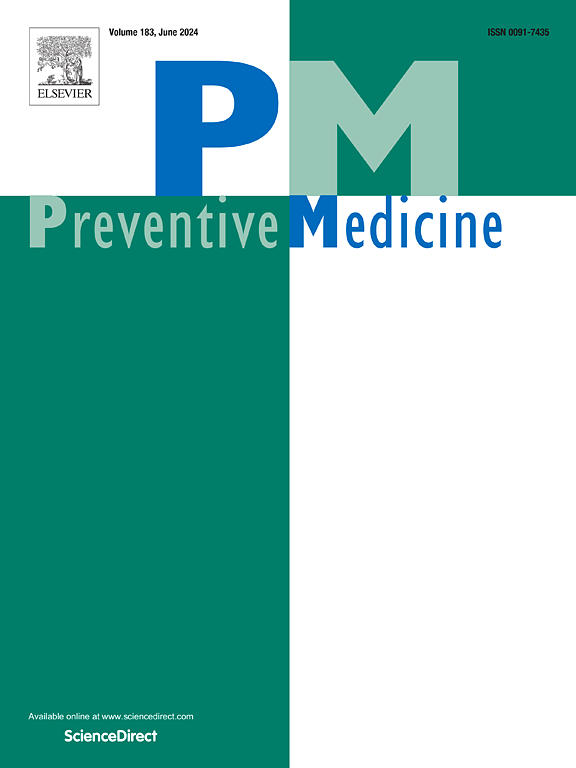2023年美国成年人报警意愿的差异:对另类危机应对方案的启示
IF 3.2
2区 医学
Q1 MEDICINE, GENERAL & INTERNAL
引用次数: 0
摘要
目的评估美国成年人在紧急情况下报警的意愿,以告知应对紧急情况和寻求帮助的政策。方法:我们利用了基于网络的2023年种族主义和健康调查(N = 5059)成年人的横断面数据,这些成年人来自东北部和大西洋中部的12个州和华盛顿特区。我们使用未调整和调整的逻辑回归估计了愿意报警的几率,这是性别、种族/民族和行为健康(物质使用或精神健康)状况终生诊断的函数。结果大多数受访者(80%)表示在紧急情况下愿意报警。黑种人中存在Dds (aOR 0.33;95% CI 0.27-0.41),美洲印第安人/美洲原住民(aOR 0.43;95% CI 0.27, 0.70)和多种族(aOR 0.36;95% CI 0.25-0.52),与白人受访者和行为健康诊断者相比(aOR 0.73;95% ci 0.61, 0.88)。女性(aOR 1.23;95% CI 1.05, 1.43)和老年人(55岁以上:aOR 4.62;95% (CI 3.70, 5.80)的人报告说,他们更愿意报警。结论:调查结果强调了警察可能不是应急响应的可行来源的亚人群,特别是少数种族和/或有行为健康问题的个人。这对依赖911调度来分类呼叫的替代响应方案具有启示意义,并突出了在警察不信任的社区中需要有针对性的信息传递和替代机制来呼叫服务。本文章由计算机程序翻译,如有差异,请以英文原文为准。
Disparities in willingness to call the police in a 2023 survey of US adults: Implications for alternative crisis response programs
Objective
To estimate willingness to call the police in an emergency among US adults to inform policies addressing emergency response and help-seeking.
Methods
We utilized cross-sectional data from a web-based 2023 Survey of Racism and Health of (N = 5059) adults in 12 Northeastern and Mid-Atlantic states and D.C. We estimated odds of willingness to call the police as a function of gender, race/ethnicity, and lifetime diagnosis with a behavioral health (substance use or mental health) condition using unadjusted and adjusted logistic regression.
Results
Most of the sample (80 %) reported willingness to call the police in an emergency. Dds were observed among Black (aOR 0.33; 95 % CI 0.27–0.41), American Indian/Native American (aOR 0.43; 95 % CI 0.27, 0.70), and Multiracial (aOR 0.36; 95 % CI 0.25–0.52) compared to White respondents, and those with behavioral health diagnoses (aOR 0.73; 95 % CI 0.61, 0.88). Women (aOR 1.23; 95 % CI 1.05, 1.43) and older adults (Age 55+: aOR 4.62; 95 % CI 3.70, 5.80) reported higher willingness to call the police.
Conclusions
Findings highlight subpopulations for whom the police may not be a viable source of emergency response, particularly individuals who are racially minoritized and/or have behavioral health conditions. This has implications for alternative response programs which rely on 911 dispatch to triage calls and highlights a need for targeted messaging and alternative mechanisms to call for service in communities with police mistrust.
求助全文
通过发布文献求助,成功后即可免费获取论文全文。
去求助
来源期刊

Preventive medicine
医学-公共卫生、环境卫生与职业卫生
CiteScore
7.70
自引率
3.90%
发文量
0
审稿时长
42 days
期刊介绍:
Founded in 1972 by Ernst Wynder, Preventive Medicine is an international scholarly journal that provides prompt publication of original articles on the science and practice of disease prevention, health promotion, and public health policymaking. Preventive Medicine aims to reward innovation. It will favor insightful observational studies, thoughtful explorations of health data, unsuspected new angles for existing hypotheses, robust randomized controlled trials, and impartial systematic reviews. Preventive Medicine''s ultimate goal is to publish research that will have an impact on the work of practitioners of disease prevention and health promotion, as well as of related disciplines.
 求助内容:
求助内容: 应助结果提醒方式:
应助结果提醒方式:


